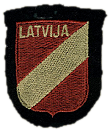A10 305 336
Riga when he and his friend were arrested by armed men in civilian clothing who spoke Latvian. They were taken to the Riga police headquarters which was the only police station in Riga. When they arrived they saw many Jews there. He concluded that all the guards were Latvians because of the language they spoke, and because no German was spoken. Some of the guards were in civilian clothing and others wore the uniform of former Latvian army members. In the police station courtyard many Jews were cleaning the courtyard with toothbrushes and he was ordered by someone to do so also (Tr. p. 401). That same man who ordered him to clean the courtyard hit his friend and later hit and kicked him resulting In his losing two or three teeth several days later (Tr. p. 452). He was selected for a work detail, but managed to escape and went to the home of his mother's aunt who lived across from the great synagogue (Tr. p. 473). Twenty-four hours later he was looking out the window when he saw blue buses arrive at the great synagogue and saw that Jews were being driven from the buses by guards wearing civilian clothing and Latvian army uniforms. He later saw the synagogue burning with the Jews inside. From among the guards he recognized the following people, whose names he had learned at the police headquarters: Migla, Damskopfs, Cukurs4, Arajs and Hazners. He saw "Hazners" wearing a green uniform pushing Jews back into the synagogue when they tried to get out (Tr. p. 50-605).
He also said that three to five days later he saw from the window of his mother's house a group of prisoners pass by on the street on the way to the prison. He said that "Hazners" was one of the guards who walked after the group. He was allegedly wearing the Latvian army uniform without any identifying marks (Tr. p. 63-696). He and his family were moved to the Riga ghetto in September of 1941 and he did not recall ever seeing the man there (Tr. p. 707). He also said that he saw "Hazners" at a courtyard of a meeting place for the S.S. and S.D. 2/ on Alunana Street in Riga in 1943 where he was working. At that time, "Hazners" was allegedly wearing an S.S. uniform with the rank of Sturmbannfuhrer, which was the equivalent of a major. On the collar he had four symbols that designated his rank (Tr. p. 1608).
The witness testified that he learned the last name Hazners from the people detained at the police headquarters, but does not remember specifically who told him the name Hazners. He never did learn the first name (Tr. p. 1479). He described Hazners as an average person wearing glasses, but did not recall if he
| 2/ | S.D. was an intelligence branch of the S.S. |
6
| 1 | Testimony of Ber Mendelkorn, 25-October-1977, direct, transcript pp. 15–93. |
| 2 | Testimony of Ber Mendelkorn, 25-October-1977, direct, transcript pp. 15–93. |
| 3 | Testimony of Ber Mendelkorn, 25-October-1977, direct, transcript pp. 15–93. |
| 4 | Cukurs only arrived in Rīga in mid-July, more than a week after the burning of the synagogue. Mendelkorn could not have possibly seen Cukurs, leading us to conclude he was testifying based on his collection of anti-Latvian Soviet propaganda materials. |
| 5 | Testimony of Ber Mendelkorn, 25-October-1977, direct, transcript pp. 15–93. |
| 6 | Testimony of Ber Mendelkorn, 25-October-1977, direct, transcript pp. 15–93. |
| 7 | Testimony of Ber Mendelkorn, 25-October-1977, direct, transcript pp. 15–93. |
| 8 | Testimony of Ber Mendelkorn, 26-October-1977, cross examination, transcript pp. 113–198. |
| 9 | Testimony of Ber Mendelkorn, 26-October-1977, cross examination, transcript pp. 113–198. |
